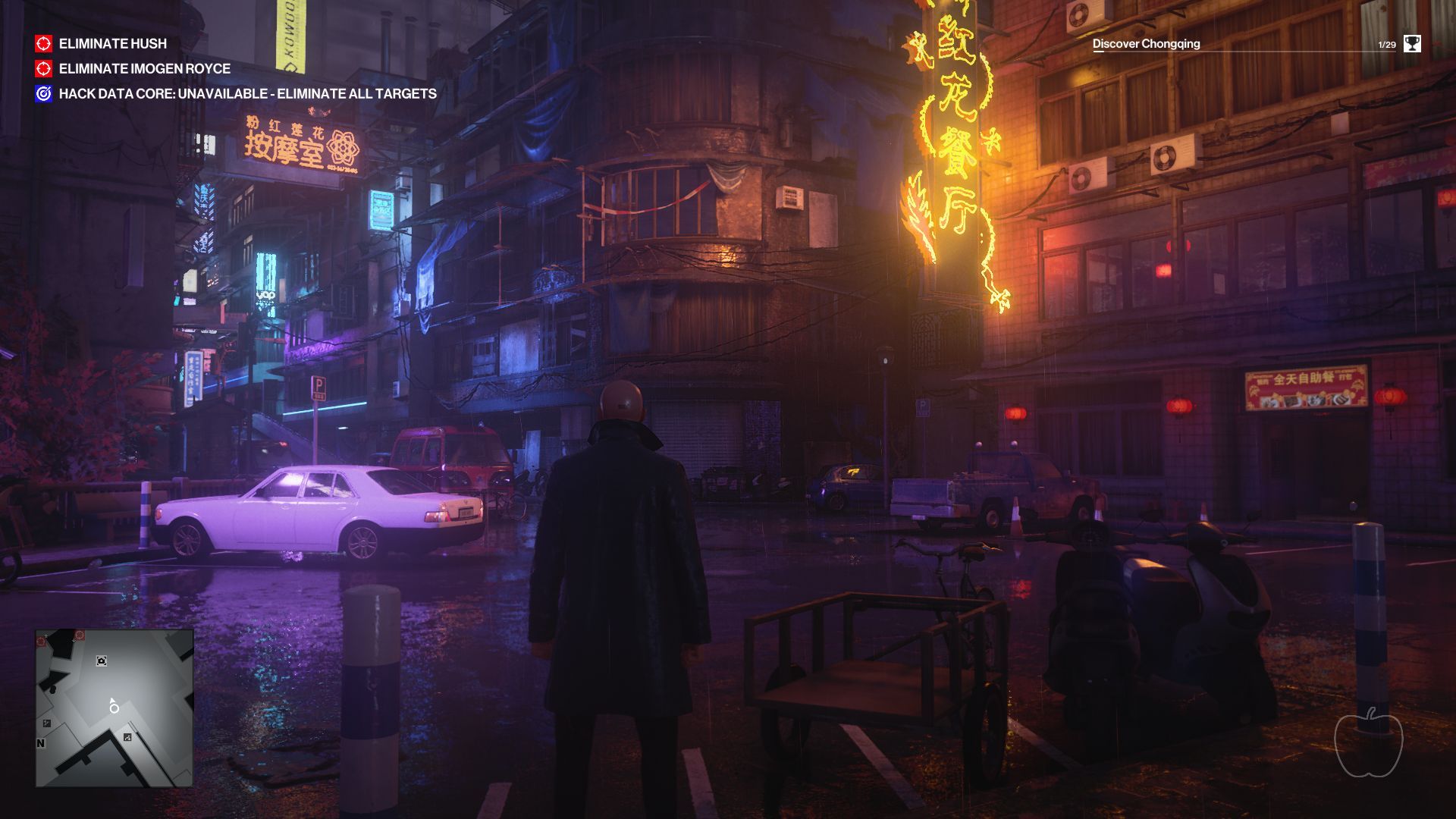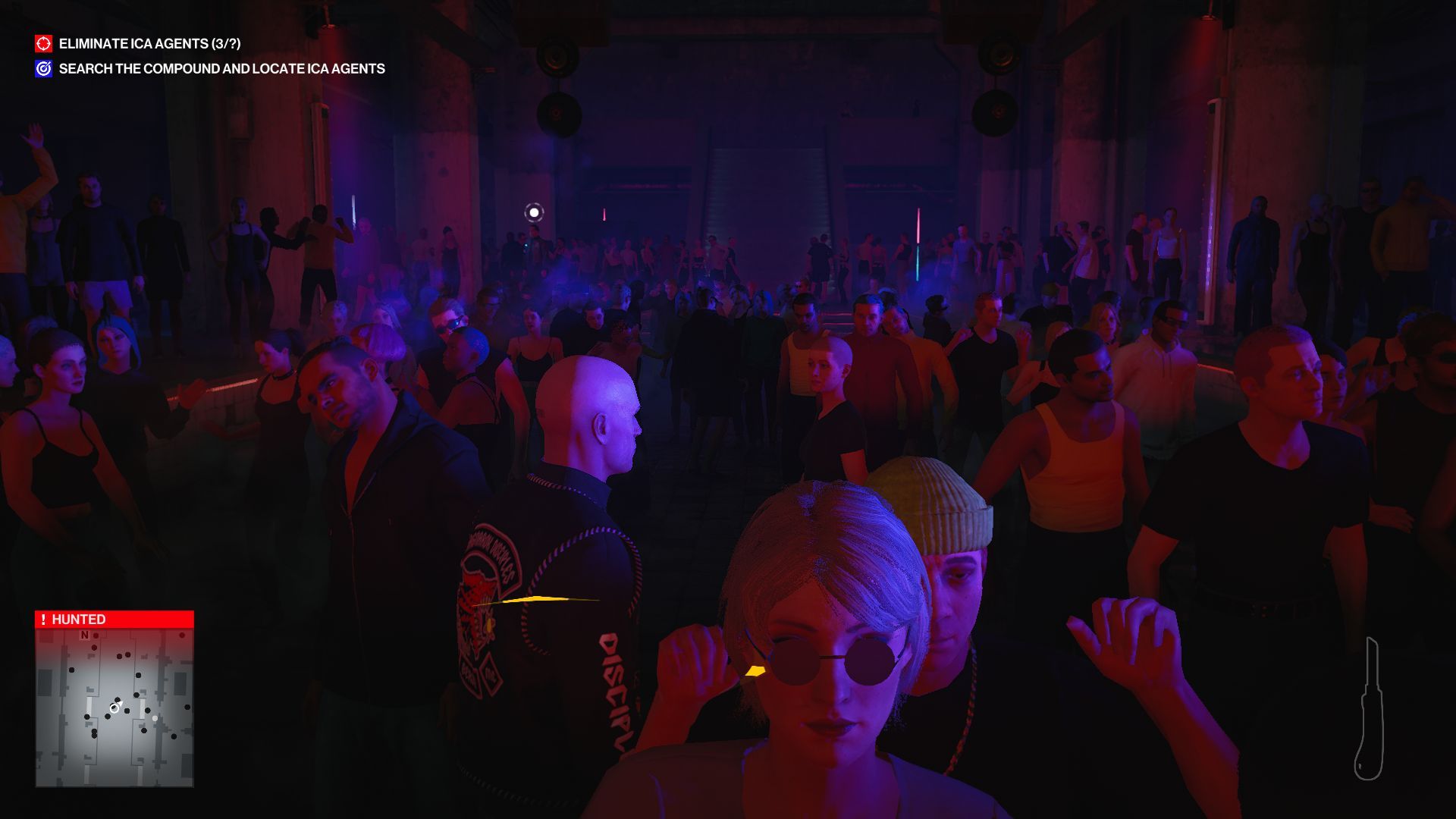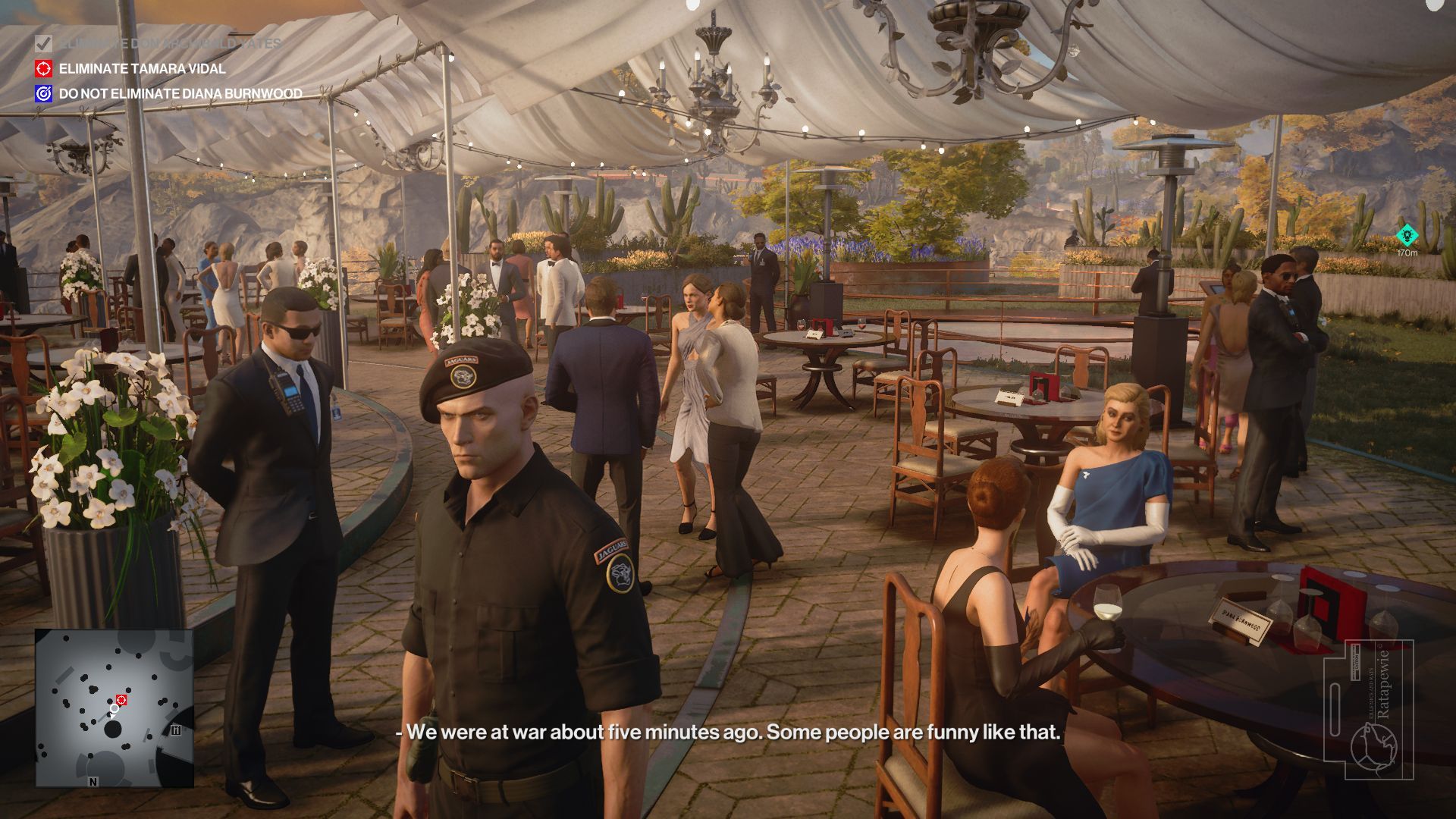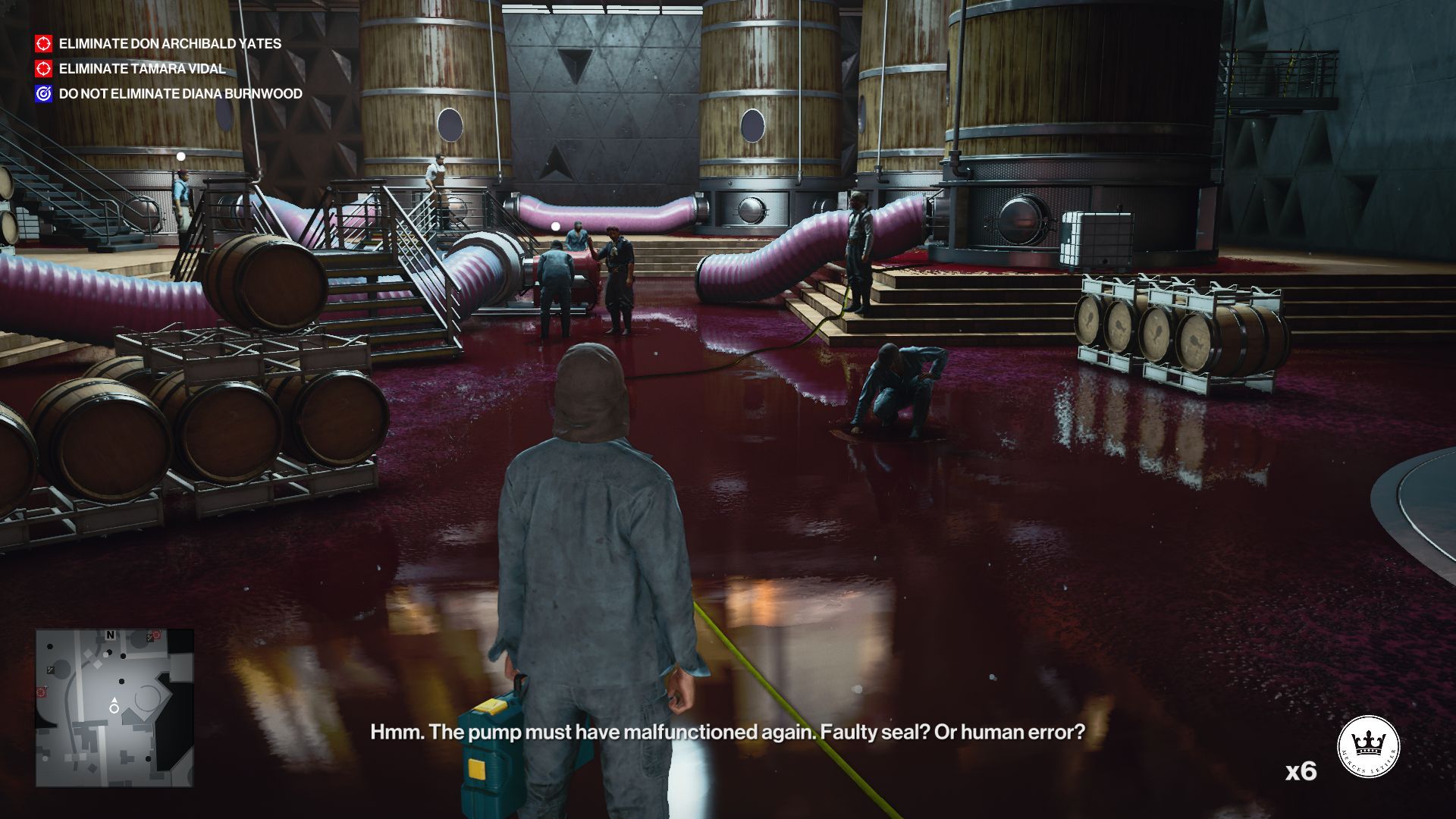Hitman 3 review
"The name's Seven... Forty Seven"
You know what you're getting into. The empathy-void assassin of the Hitman trilogy is an anti-Santa who only has a "naughty" list and never a "nice" one. He visits the rich and powerful once every couple of years, to shove lumps of coal down their throat because they've been selling AK-47s to babies.
Here he is again in the final instalment of the most recent righteous murder trilogy. Hold Hitman 3 in your hands and you might remark it feels "a bit light", with the suspicious eyes of someone whose favourite cereal seems to have fewer flakes in the box every time they buy it. But what's inside still has that crunch and flavour you like, so it's hard to grumble when you're stuffing your face. Mmmmm, Emetic Poison Bran.
In terms of story, we left barcode boy with some new friends and a list of names - the head honchos of various dynasties who secretly rule the world from shadowy board rooms. You know the type. You're off to take care of them amid spy thriller plot twists that see you flying from Dubai to Germany, from China to Argentina. As ever, levels are sprawling clockwork toys of NPC routines, comical eavesdropping, and gleeful killing opportunities. Pose as a waiter to neatly pour your target's poisoned wine, or lure them into the cellar to bludgeon them with the bottle.
The new thing in our bald friend's arsenal is his camera, which doubles up as a hacking tool. Throughout levels you'll see terminals that let you open doors or windows from across the room with the hackcam. It's sometimes helpful, but not a significant change in the way that Hitman 2 introduced pop-up windows showing events in other rooms, or allowed you to blend into crowds. It is not exactly a revolutionary tool in 47's bulging blazer pockets. Some later uses of the hackcam include opening vents which can be opened with a simple screwdriver anyway. I only mention the camera because its addition marks the only real mechanistic difference between Hitman 2 and Hitman 3. Everything else about moving, sneaking and shooting feels identical.
So if you asked me "what is new?" I'd have to admit it's only the levels. Maybe that's enough. Taken together, the trilogy is a cracking showcase of level design, and Hitman 3 has some of the best so far. You might have already read Alice B's misadventures in a mansion in Dartmoor, England, where you can disguise yourself as a private investigator and take part in a full-on murder mystery. This level is the first clue that the designers have decided to throw any remaining plausibility (about 0.01%) out the window and have a party. The mansion is an upper class wonderhome, all dark mahogany and priceless antiques. Filled with bodyguards, maids and gardeners, it's as much a grimly smiling parody of Downton Abbey as it is a meta-murderous take on Poirot.
This is in keeping with moderno-Hitman's pedigree as a game about maintenance workers killing their paymasters. The targets throughout are as despicable as usual. Often rich, always vile, they are heirs of vast oil empires, or owners of manipulative media conglomerates. As usual the story drapes a thick veil of conspiracy theories over all its corpses-to-be. But more on that poisoned chalice in a moment. I was talking about the levels.
It would be gauche to say "Hitman 2 is the best" or "Hitman 3 is better". Because when I think of Hitman, I think of individual levels, as if it were really all one game (which it sort of is, if we're being honest). I think of Marrakech, Mumbai, Sapienza, Colombia. And among those favoured levels I can now confidently add the mansion of Dartmoor and the rainy streets of Chongqing, a level in this third game that's got to be the best-looking of the lot, the exact kind of urban labyrinth I love in any game. If you sat down 10 Hitman fans and told them to come to a consensus on the best level of the series, nobody would leave the room alive. I'm glad to report Hitman 3 only adds to these arguments.
In other ways, it feels like the developers, IO Interactive, are flexing their Bond muscles in anticipation of their upcoming 007 game. They like to push the "murder this person" formula down some interesting alleys. We saw a bit of this in the previous instalment, when 47 went to Mumbai. You didn't know the exact identity of one of your targets, only an alias, and the rest you had to figure out before finishing the job. In this trilogy-ender, that twistiness pops up again. One mission in a German factory-turned-nightclub sees you eyeing up clubbers and bar staff with paranoia as an unknown number of undercover agents pursue 47 through strobe lights and wub-wub. Leading, in my case, to a cool re-enactment of the Bondy trope of melting into the dancing crowd, pissheads and flashing lights covering a nervous escape.
Another mission might see you using an algorithmic super-AI to fire the employees of an underground facility. Giving these workers the axe (only the proverbial one, 47!) has some messy, yet productive, results. In practice, this is a simplistic sequence of button presses on a sci-fi CCTV monitor but, thematically, I enjoy the message. Treat your employees like pawns and you'll get burned. It's these scenarios, along with the The Mysterious Affair At Dartmoor, that proves IO Interactive's mission designers have reached peak comfort levels with Hitman's fundamental silliness. I half expect their 007 to show up to his first party, completely bald, speaking in a deadpan American accent and insisting his name is James Bond.
There's one level, set in the sunny vineyards of a powerful Argentinian family, where the mega rich have come to tango and sip Cabernet Sauvignon while gossiping amongst themselves. The happenstantial dialogue that triggers as you walk through this soiree is full of references to the previous games. Remember that arms manufacturer you killed at a race track in Miami in Hitman 2? Well, the new CEO of his company is here, chilling out as an NPC. Remember the lead singer you killed in Bangkok in Hitman 1? There's one of his former band members in the crowd. Even one of the mercenaries guarding the wine cellar gets in on the fun, complaining about his time spent protecting an Italian aristocrat in Sapienza. "The rich are weird," he says, as your memory flashes back to killing a wealthy man with an exploding golf ball in 2016. The Argentine mission is both high society assassination job and love letter to the developer's dangerous little universe. It's very pleasing.
This focus on the elite does mean the queasy parallels to the conspiracy theories of our own world are in plain sight. Given the recent surge in tin foil hat wearers, it's a missed opportunity that the story doesn't try to upend this kind of delusion, to subvert the unhealthy allure of the conspiracy theory. But it might be a bit late for that. Not to mention a tall order for a game which is ultimately about electrifying the head of a law firm in a puddle of his own wine.
The plot is at least more grounded in reality than any Metal Gear Solid nonsense. Arms dealers and petrochemical magnates do exert some control over our nations through lobby groups and legal strong-arming, after all. And these are the actions that Diana (your earpiece helper and Edmond Dantès of the Hitmanverse) will note as qualifications for the "naughty list". Through pantomime villains and stylish mission briefings worthy of a HBO credits sequence, the Hitman games manifest these companies, corporations, and cartels into sneering human beings, served oven-ready, waiting for you to push them off balconies. It's less "heroic QAnon operative frees the world" and more "a garbage man has killed the entire board again, somebody get the mop".
One downer. When Hitman 3 finally empties its pockets, it comes up a bit short. There are six levels, but the final level is linear and setpiecey, a total contrast to the rest of the series. It fulfils its function as a swish-looking finale, but in terms of everything Hitmanists love about the games (the poking around, the sprawl, the thread-following) this ultimate on-rails mission is the weakest moment of the whole trilogy. For a man who fires a lot of lethal rounds, 47 ends his story on a damp squib. Although it is possible to carry an expensive Fabergé egg from the beginning of this level the whole way to end, and welt it at the face of the final antagonist with deep satisfaction. So that's neat.
On top of that there have been mixed messages about whether owners of the previous games will be able to import those old levels (and character stats) into this new game. Yes, the developers say, PC players will be able to do this, but the solution they've come up with still isn't clear, requiring buyers of this 1-year Epic exclusive to solve a deadly marketing riddle in order to decipher whether or not they will get their old levels when they buy this game. This is the kind of store-bound nuisance that detracts from the quality of the level design and the great hi-jinks of the game itself. It devalues what is already a £50 game. And when I remember that last linear killathon, it does feel like this is the Hitman that offers the smallest buck-to-bang ratio. In a sense, this has often been the case with Hitman. They always become more inviting as DLC levels trickle out and a sale puts everything into one basket. This will be no exception.
Since its episodic beginnings, you know what you're getting into. With Ian Hitman, you know you're getting some world-class level design, some tense moments of dark comedy improv, and a type of clockwork murder toy that nobody else makes. As a final act, Hitman 3 is as capable and pleasing as its trilogy-siblings. As a trilogy, it is one of the most fun-loving games of the previous decade. It is like Ian himself - reliable, dry-humoured, uniformed. The best murderer money can buy.













